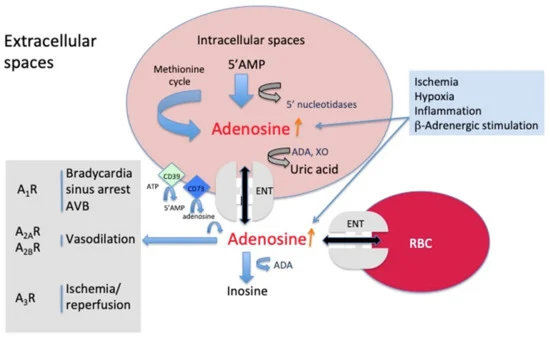Black Friday Sale
Dear Friend,
This week, my publishers have released a special Black Friday Deal, offering a massive 30% DISCOUNT on my textbook, “The Revision Guide to Core Clinical Medicine.” In order to use this, you can buy the book directly from World Scientific Publishing using the following discount code at checkout. This code will be active for the next 7 days!
WSQ0433
The code will also work for any international orders, and World Scientific has delivery options all around the world. Click here to redeem your discount!
Drug of the week
Adenosine
Adenosine binds P1 receptors which are Gi coupled. This leads to hyperpolarisation of the AV node which causes a transient heart block that slows the heart rate.
It is used for treating supraventricular tachycardias and has a half-life of 8 seconds.
It is contraindicated in asthma as can cause bronchospasm.

A Brain Teaser
A 67-year-old woman presents to the ED with palpitations that began earlier in the day. She reports no episodes of syncope or chest pain. Her medical history includes asthma and hypercholesterolemia.
On examination, she appears pale. Vital signs are as follows: heart rate 167 beats per minute, blood pressure 124/92 mmHg, respiratory rate 19 breaths per minute, and temperature 36.1ºC. An electrocardiogram (ECG) shows a regular rhythm with tachycardia and QRS complexes measuring 0.20 seconds.
What is the most appropriate management for this patient?
A: IV adenosine
B: IV amiodarone
C: IV atropine
D: IV lidocaine
E: Synchronised DC cardioversion
Answers
The answer is D – IV amiodarone.
The correct answer is IV amiodarone. The patient presents with symptoms of palpitations, accompanied by tachycardia. An electrocardiogram (ECG) demonstrates a regular rhythm with broad QRS complexes, as their duration exceeds 0.12 seconds. Ventricular tachycardia is the most probable diagnosis, necessitating immediate intervention as this arrhythmia compromises adequate ventricular filling time, leading to diminished stroke volume and cardiac output. Intravenous amiodarone, a potassium-channel blocker, should be administered at a dose of 300mg over 10-60 minutes to resolve the arrhythmia. Should this measure fail, synchronised DC cardioversion may be considered for up to three attempts.
IV adenosine is indicated in the management of supraventricular tachycardia characterised by narrow QRS complexes (less than 0.12 seconds). Given that the QRS complexes are 0.2 seconds in length, ventricular tachycardia is the appropriate diagnosis; therefore, adenosine would not be the correct treatment choice.
IV atropine is utilised in cases of bradycardia when heart rates fall below 60 beats per minute. As the patient’s heart rate is significantly higher at 167 beats per minute, administering atropine would be contraindicated.
IV lidocaine may serve as an alternative to amiodarone in the context of cardiac arrest for treating ventricular arrhythmias. However, while this patient exhibits severe symptoms, they are not in cardiac arrest; thus lidocaine does not constitute an appropriate therapeutic option under these circumstances.
Synchronised DC cardioversion has its place in managing ventricular tachycardia when administration of 300mg amiodarone proves ineffective or if there’s hemodynamic instability. In this scenario, pharmacological management has yet to be initiated and the patient is haemodynamically stable. Consequently, proceeding directly to cardioversion would be premature.





